Repeat customers are more profitable than one-time shoppers.
41% of an ecommerce store’s revenue is created by only 8% of its customers, and your top 5% of customers generate 35% of revenue.
The benefits of repeat customers include that they shop more often, are easier to sell to, spend more per purchase, spend more at key times, and generate UGC.
Identify repeat customers with insights from loyalty programs, ecommerce platforms, social media, and customer accounts.
Increase repeat customers with strategies like loyalty programs, referrals, email and SMS communications, subscriptions, and customer experience.
Editor’s Note: This post was originally published on April 27, 2015, and was updated for accuracy and comprehensiveness on May 7, 2024.
Let’s say you noticed your business wasn’t acquiring as many new customers as you expected, and you want that to change. Well, believe it or not, one of the most sustainable ways to improve your customer acquisition cost is through customer retention. The reality is that the customers you already have are the most profitable, and it’s worth your time and effort to keep them around!
Before you get ahead of yourself, let us explain. Obviously, acquisition is essential because you can’t have a repeat purchaser if they never make that first purchase. However, the problem is that the average customer acquisition cost has increased from $9 in 2013 to $29 in 2022, a 222% increase.
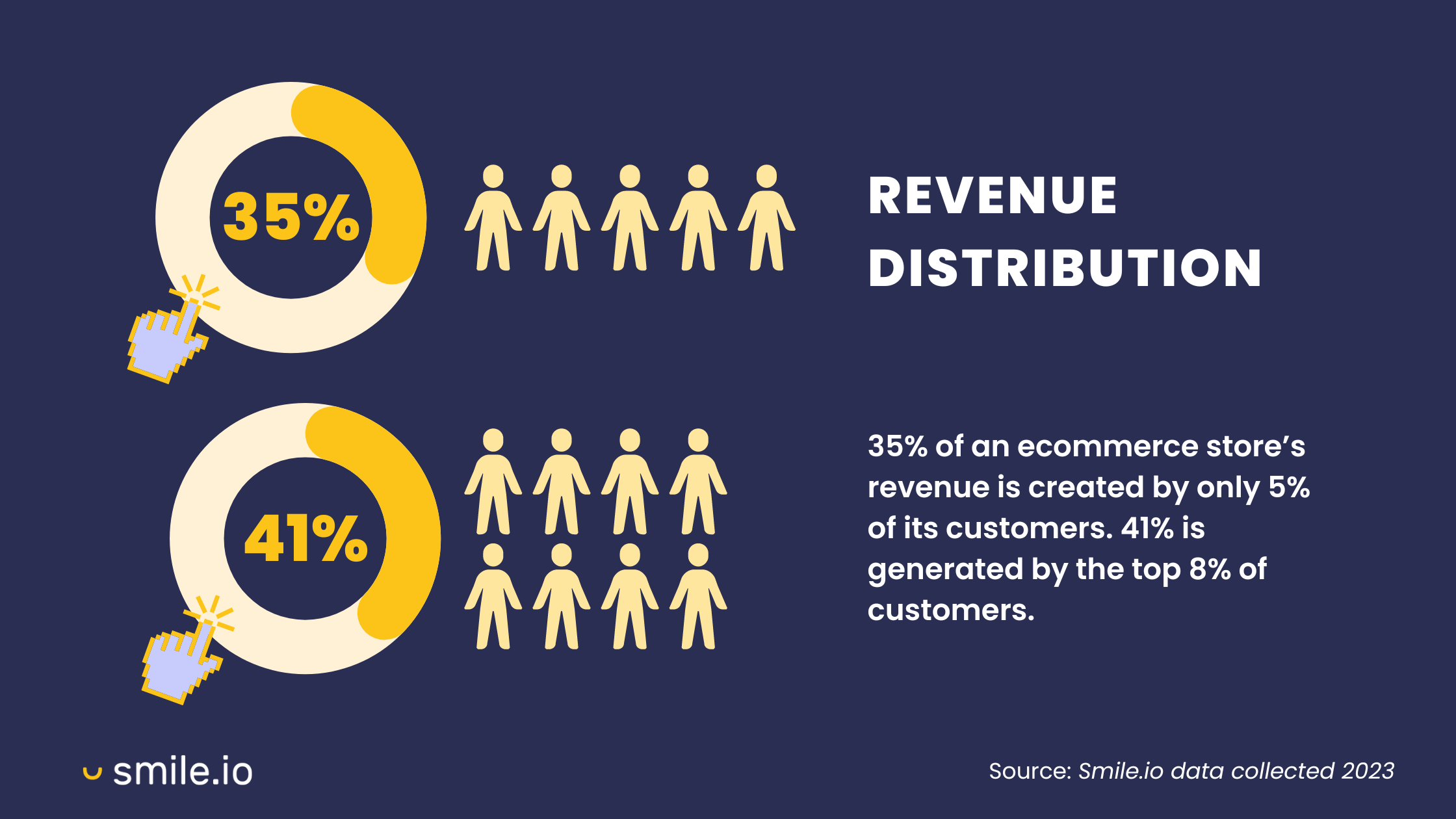
Although acquisition is an essential first step in the customer journey, prioritizing it seems odd when you consider your revenue distribution. According to data from Smile.io’s expansive network of commerce businesses, 41% of an ecommerce store’s revenue is created by only 8% of its customers, and your top 5% of customers generate 35%. This 5% is made up of your most loyal repeat customers, making it clear that they are incredibly profitable!
We’ll review the stats that illustrate the power of repeat customers and the profits they represent. These stats are based on Smile Rewards’ all-time numbers from a sample of over 1.1 billion shoppers and 250 thousand ecommerce brands. By the end, we guarantee you’ll have the proof you need to believe retention marketing is worth adding to your marketing toolbox.

Table of contents:
- What are repeat customers?
- 5 reasons repeat customers are profitable
- How to identify repeat customers
- How to increase repeat customers
- Repeat customers are important
What are repeat customers?
Repeat customers are shoppers who make at least 2 purchases during their lifetime with your store. Your most loyal customers and brand advocates are repeat customers.
The goal of all commerce retention strategies is to increase the percentage of your customer base that are repeat customers. Growing your repeat customer base generates more revenue, lowers total acquisition costs, and increases your store’s profitability.
This is because repeat customers offer many benefits—both from a brand reputation and financial aspect. They are easier and cheaper to sell to and often recommend your brand to others. Focusing on repeat customers as your commerce business scales becomes increasingly more important than acquisition.
5 reasons repeat customers are profitable
1. A repeat customer is more likely to shop with you again and again
We know what you’re thinking—this seems pretty obvious. After all, a repeat customer is, by definition, a site visitor that has made at least two purchases. What's interesting, however, is that a customer becomes increasingly more likely to buy from you again as their amount of purchases increases.

After one purchase, a customer has a 27% chance of returning to your store. While that’s not a horrible return rate, if you can get that customer to come back and make a second and third purchase, they have a 49% and 62% chance of making another purchase, respectively.
You may be wondering how you can inspire your customers to make that second or third purchase, and the trick is to be careful with how you entice them. While you may immediately think giving a discount on the next order is a great way to get a customer to return, you should be cautious with this tactic. Discounts are effective at getting a customer back, but they almost always set an expectation for your customers that you may not always be able to fulfill.
- Sophie Coleman, Co-Director of Oatopia
Customers who receive a discount either start to expect a discount every time, wait until a discount exists to make another purchase, or use hacks like the one above to cash in extra discounts. Instead, we recommend using sustainable retention tools like loyalty programs or personalization to encourage customers to return to your site.
2. A repeat customer is easier to sell to
While conversion rates in ecommerce are highly volatile and vary by industry, most experts estimate that the average conversion rate is between 1% and 3%.
- Smile.io data
One of the most critical retention metrics is your repeat purchase rate or the percentage of your current customer base that has purchased at least a second time within a year. When a customer joins your loyalty program, they show intention to revisit your store and become a repeat customer.

Similarly, with repeat customers or loyalty program members, you’ll have to put less effort into your marketing because they will already be part of your database. You can send them automated email campaigns and spend less on conversion tactics like abandoned cart offers.
- Smile.io data
As you can see, customers who join your loyalty program save you time and money on marketing and conversion efforts.
3. Repeat customers spend more on each purchase
Not only do repeat customers convert more often, but they also have a higher average order value than first-time buyers. This means your repeat customers are buying more often from your store!
The number of previous purchases and how long they’ve been a customer directly impacts how much a repeat customer spends.
Let’s look at the first factor affecting how much a repeat customer spends–the number of previous purchases. Smile.io data reveals that, on average, the top 10% of customers spend 2 times more per order than the lower 90%, and the top 1% spend 2.5 times more than the lower 99%.
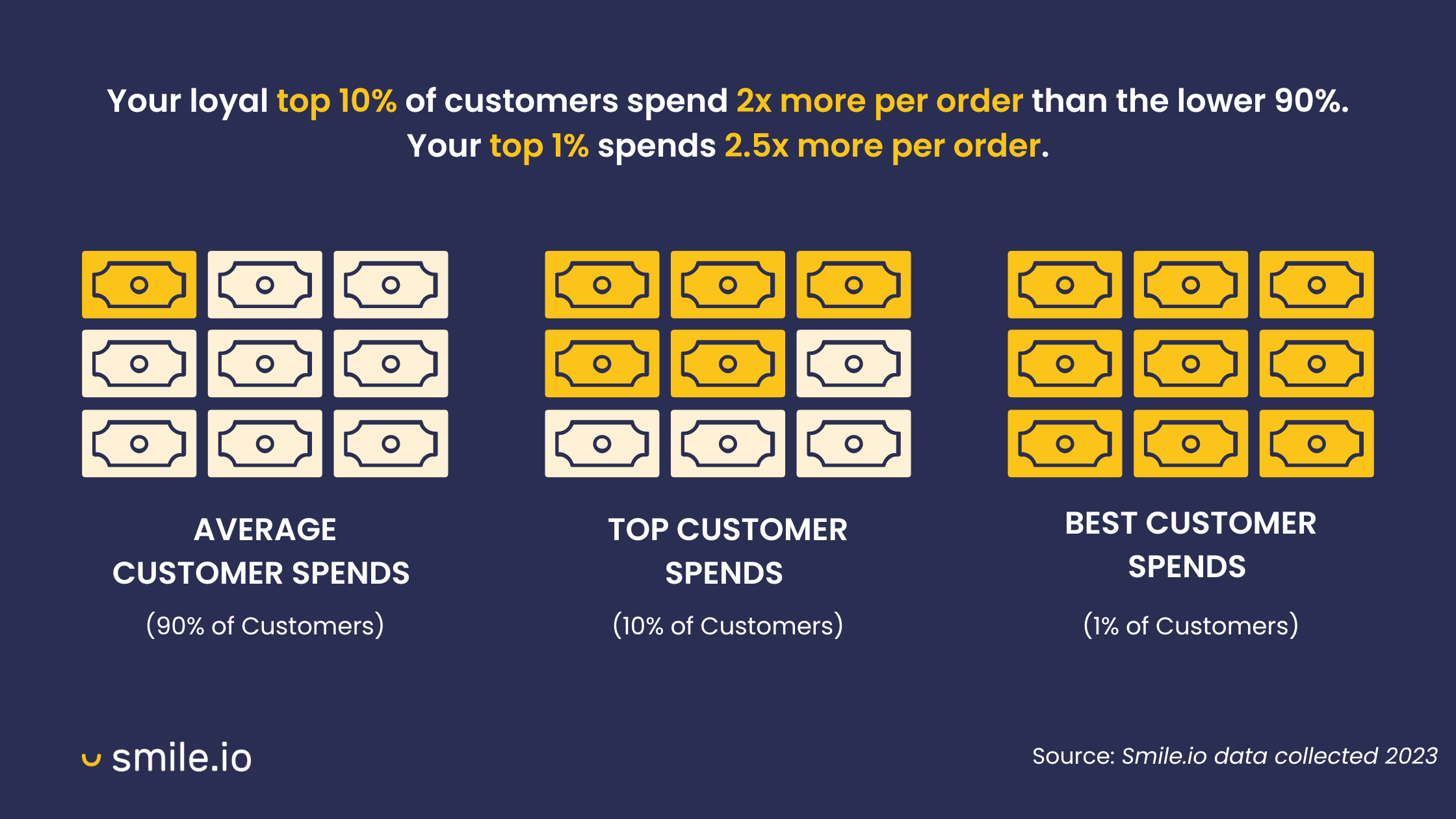
The next important factor is how long a customer has been shopping with you. Our research indicates that the longer customers shop with your brand, the higher their average order value will be for most industries. For example, beauty and cosmetics shoppers purchase 30% more per order after shopping with a company for 6 months and 45% more per order after 36 months.
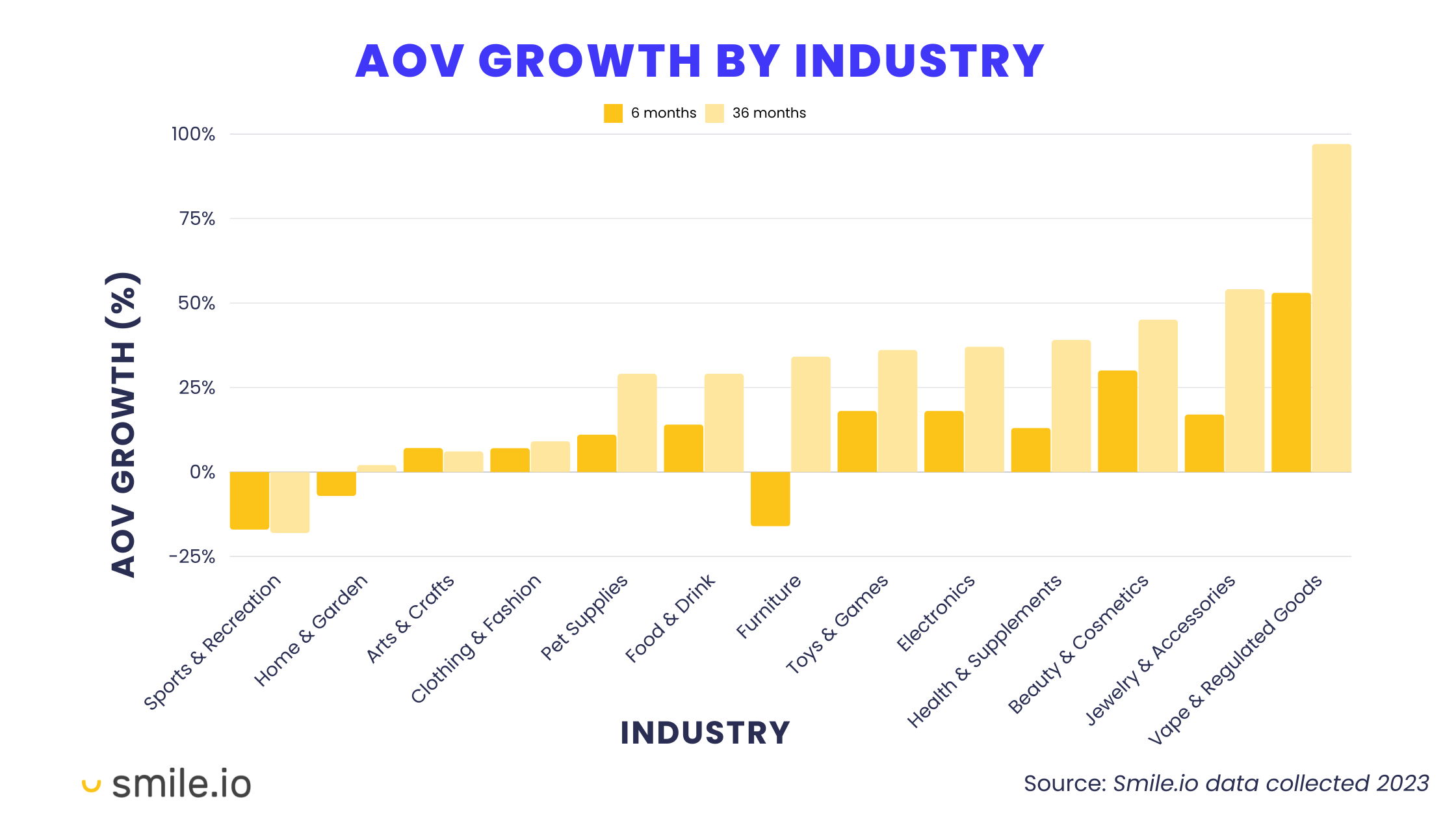
As you can see above, most categories’ results are similar. Repeat customers have a high lifetime value, contributing to a higher value per order over time.
4. Repeat customers spend more at key times
Most ecommerce merchants make the bulk of their revenue during one particularly busy season. If you sell bathing suits, you’ll see a spike in March or April. If you sell costumes, you will see a spike in October. That being said, the busy time for most merchants is between Black Friday, Cyber Monday, and Christmas.
The surge in sales comes from increased demand, leading to more potential shoppers and people purchasing more due to the season. But how much more do consumers buy in the busy season?
In the holiday shopping period of November and December 2022, 38.4% of all customers with Smile.io merchants were repeat customers, placing at least their second order with the brand. This means that Black Friday Cyber Monday is not only a great time to acquire customers but also the perfect season to appeal to repeat customers.
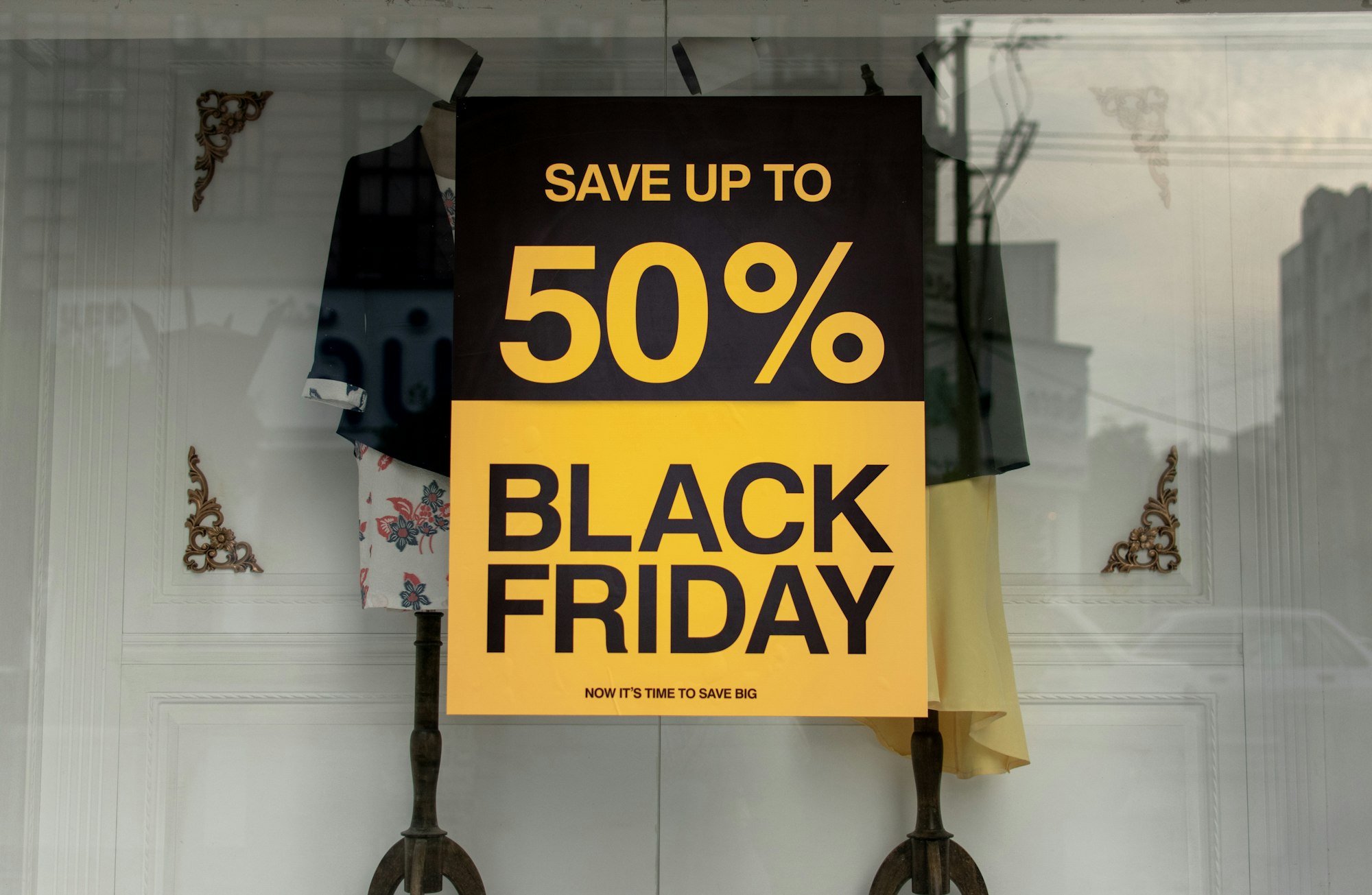
5. User-generated content from repeat customers is profitable
Not only are repeat customers more valuable when shopping, but they also provide you with some massive marketing potential. A repeat customer gives your store increased word-of-mouth advertising through earned user-generated content, which is almost always regarded as the best kind.
You’d be hard-pressed to find a successful commerce brand that isn’t leveraging user-generated content. This can come in social media posts, video content, online reviews, or anything else a customer creates. The reason? UGC is exceptionally profitable.
- Power Reviews Research
With consumers ranking UGC as the most trustworthy content type in 2023, it is a great way to build authentic relationships with your consumers. One way to leverage UGC is by rewarding customers with loyalty points for leaving reviews on your website. You can even offer bonus points for photo or video reviews since 90% of consumers stated that videos influence purchasing decisions.
- Brightlocal, 2023 Review Study
With 37% of consumers only leaving reviews for positive experiences and only 7% leaving negative reviews, you can encourage repeat customers to leave positive reviews. If customers are satisfied enough to make a repeat purchase, they’ve begun building true loyalty with your brand. Given the significant upside profit potential of positive UGC, these are the perfect customers to ask for reviews.
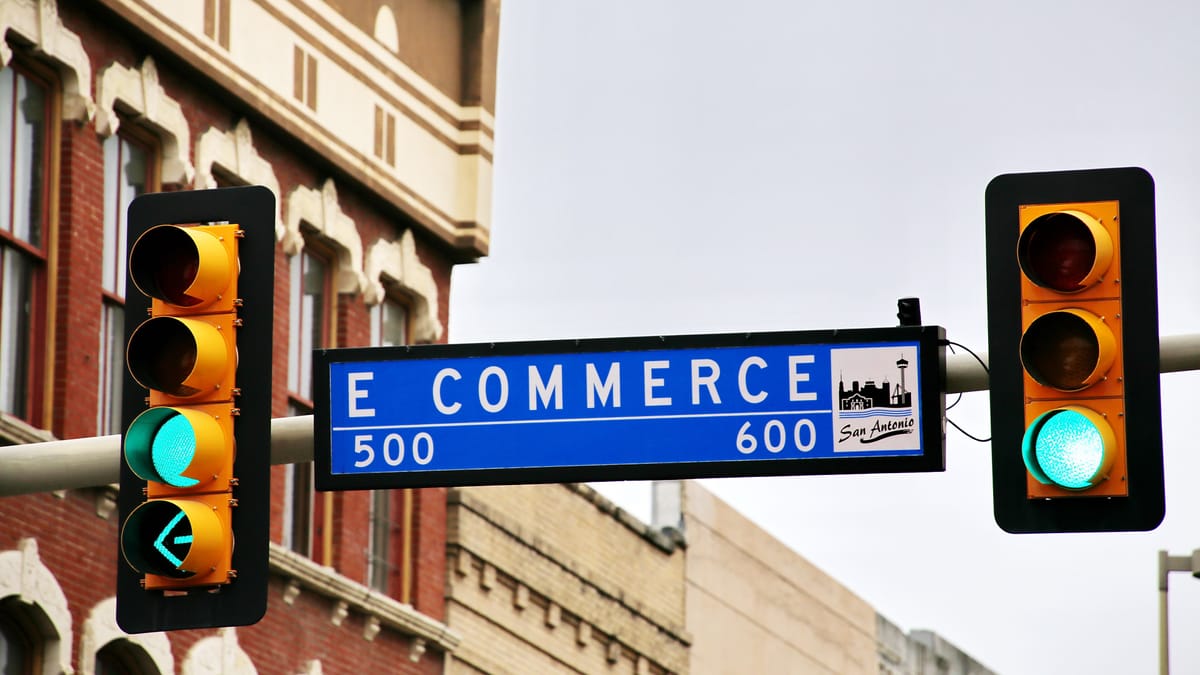
How to identify repeat customers
Repeat customers spend more, order frequently, and improve your brand reputation. But how do you know who your repeat customers are?
- Loyalty program data.
- Ecommerce platform data.
- Social media and online communities.
- Unified customer accounts.
Loyalty program data
One of the best ways to both increase and identify repeat customers is with a loyalty program. Rewards programs incentivize repeat purchases by offering value, perks, and benefits that accumulate with each purchase.
Loyalty programs provide customer feedback and insights that inform your business decisions. Elevate your loyalty and retention strategy by measuring your rewards program analytics.
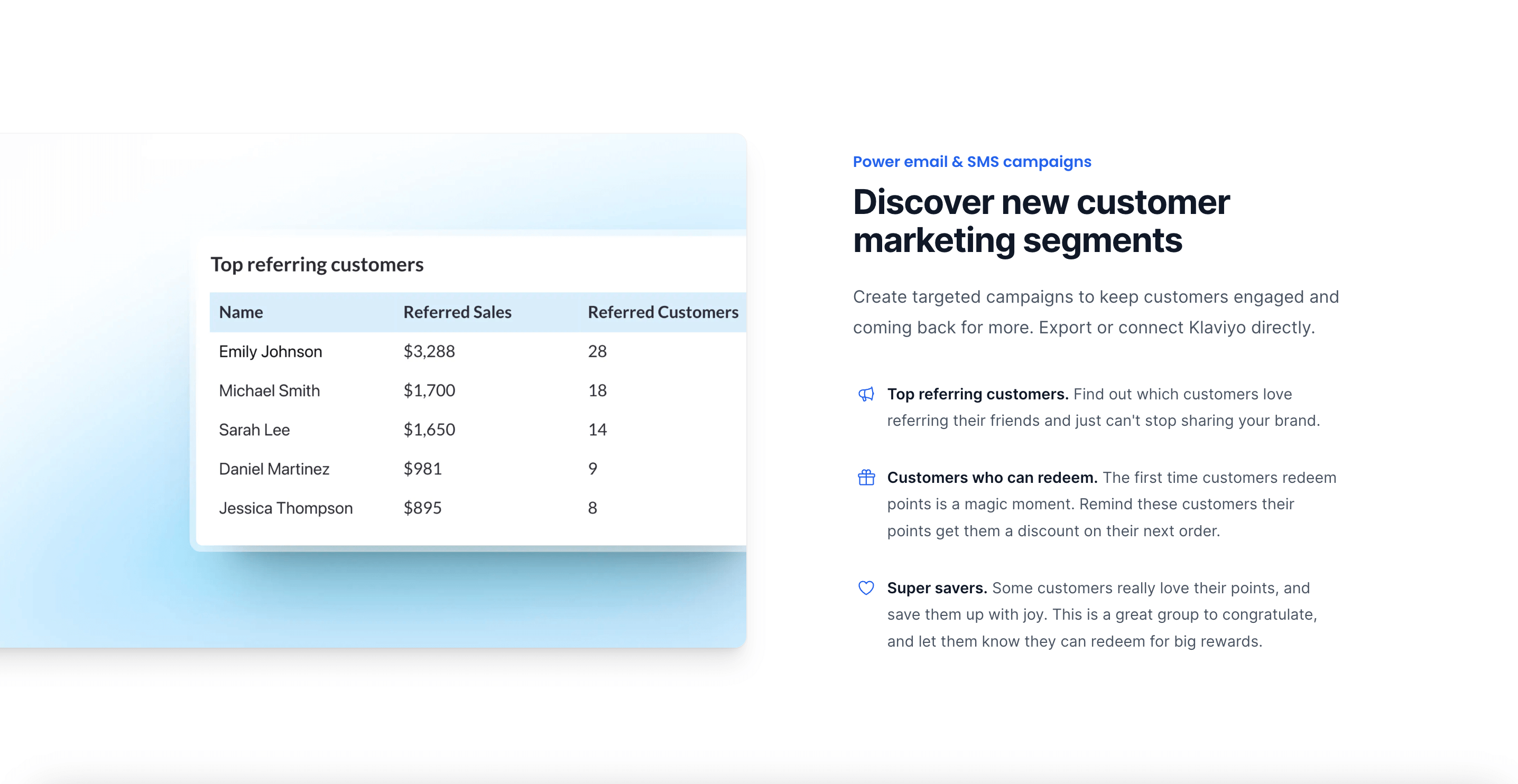
A few key loyalty program metrics to identify repeat customers include:
- Top customer lists. Identify your top earners, redeemers, and referrers to see who is most engaged in your rewards program.
- VIP tier members over time. Customers move into new tiers as they build up their points balance of annual spend. Seeing which customers have entered new VIP tiers lets you know who is making repeat purchases.
- List of customers who can redeem. The first time customers can redeem points is a magic moment. These customers have placed multiple orders, and it’s a great time to reach out and remind them of the value they’ve unlocked to drive another purchase.
Smile.io Analytics gives you access to 25+ specialized pre-built reports to understand your program’s success. Get started with Smile Plus to gain access to the reports.
Ecommerce platform data
Your commerce platform provides valuable insights to help you identify repeat customers on a holistic or granular customer-specific level.
For example, Shopify Analytics and Reporting provide ecommerce insights in real-time. Examine reports like Returning Customer Rate to see what percentage of your consumers make at least their second purchase.
You can calculate your repeat purchase probability to plan for future marketing activities.

Unified customer accounts
As customers shop across new channels and formats, unifying customer profiles is essential. With the rise of omnichannel retail through social commerce, marketplaces, and search, brands must integrate the customer experience with traditional retail channels like brick-and-mortar stores and ecommerce sites.
Customers want to start a buying process on one platform and pick up where they left off on another. To do this, you need to have technology in place to aggregate customer data into one account.
With tools like Shopify POS, you can integrate your online and in-store customer data using phone numbers and email addresses. This allows you to identify how long someone has been a customer, their previous purchases, how frequently they order, their lifetime spend, their product interest, and more (regardless of the channel).
Monos is a DTC travel and lifestyle brand that has recently expanded into physical retail locations. By leveraging the Smile.io and Shopify POS integration, they can reward customers for online or in-store purchases. Customers can then redeem rewards and discounts in-store for points they’ve accumulated online.
- Mike Wu, Director of Ecommerce at Monos
Social media and online communities
Your top repeat customers are most likely to be brand advocates—vocal members of your brand community who show outsiders the value of your brand through peer-to-peer referrals and word-of-mouth marketing.
Loyal brand advocates often share their devotion with user-generated content like social media posts and reviews or testimonials in online forums. Monitoring online sentiment with social listening tools lets you quickly identify repeat customers.
Rad Revolution is a bag shop that offers adventure, travel, wallet, and mini handbags. With a thriving community of parents looking for gender-neutral, stylish baby items, Rad Rev has built a devoted brand community. They leverage this advocacy with a loyalty program that rewards customers for social media engagement and referrals.
- Mallory Boren, Founder of Rad Rev
How to increase repeat customers
Increasing your repeat customer rate drives profitability, lowers your overall customer acquisition cost ratio, and generates a positive brand reputation.
There are several strategies to increase repeat customers:
- Add a loyalty program.
- Leverage referrals.
- Send personalized email and SMS marketing.
- Offer subscriptions.
- Deliver a seamless customer experience across channels.
Add a loyalty program
The best way to increase repeat purchases is to offer customers a reward for them. Adding a points or VIP program to your store creates a switching cost for customers. If they know they are close to a discount or reward, they’ll want to continue shopping with you over a competitor.

Setting up a loyalty program for your Shopify store is fast and effortless with Smile.io. Regardless of your business size, you can customize a loyalty program to grow repeat sales—no coding required.

By leveraging a Smile.io loyalty program and the bonus points campaign feature, Sloane Tea boosted daily sales by 370% in 24 hours. By informing their customers who had previously purchased about the bonus points event, Sloane Tea drove repeat purchase conversions using rewards as incentives.
- Laura Spinelli, Digital Marketing and Content Specialist
Leverage referrals
Along with points and VIP loyalty programs, offering referral rewards is a natural next step in the customer loyalty journey. Once you’ve identified your repeat customers, it’s time to leverage them.
Referral programs are an effective, sustainable customer acquisition tool that won’t break the bank. Referral programs offer the sender and receiver desirable rewards, like in a classic “Give $10, Get $10” configuration. You’re simultaneously incentivizing retention and acquisition by encouraging repeat customers to share unique referral links with their networks.
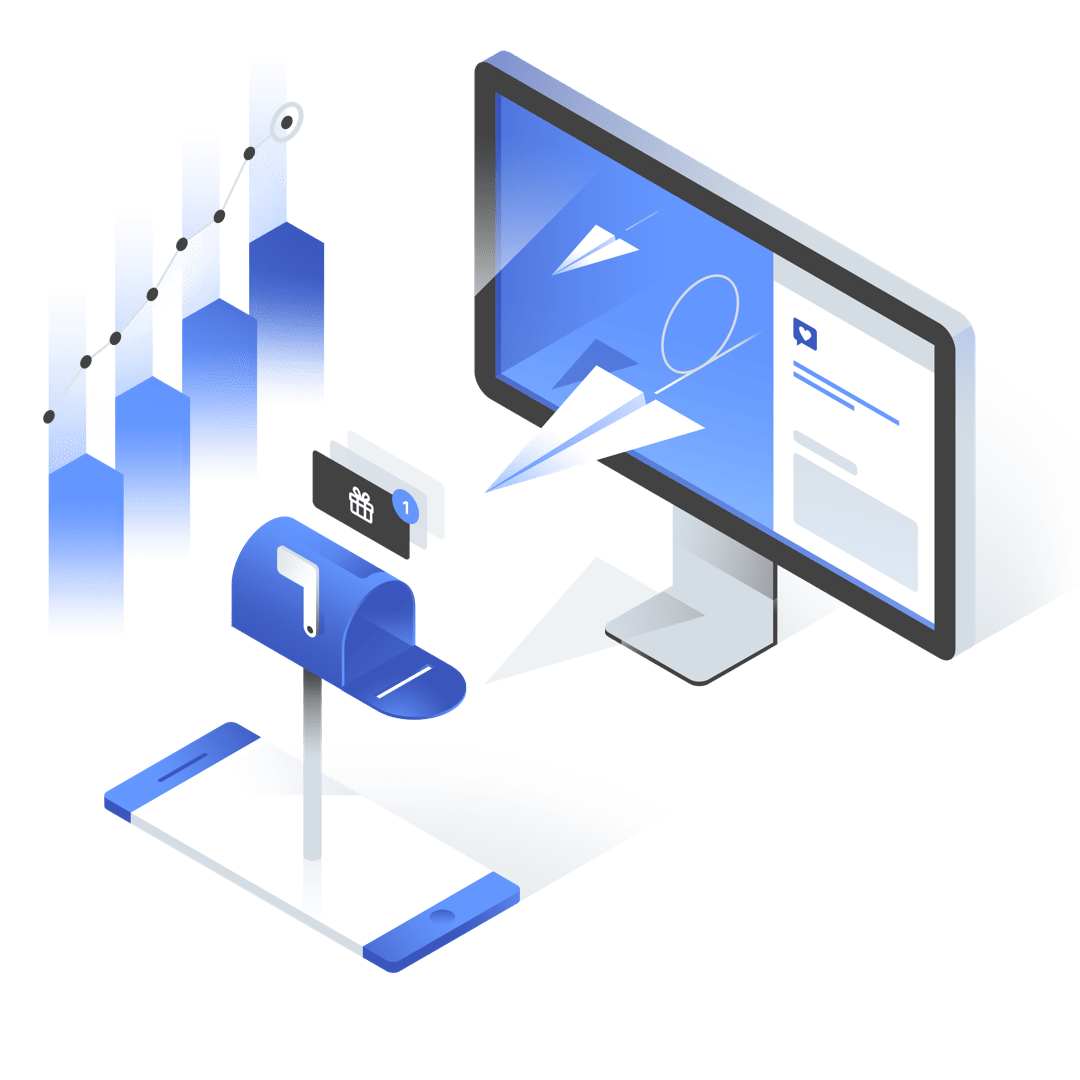
Once a customer makes a successful referral (the person they sent the code to makes their first purchase), they’ll receive a reward. They’ll have to return to your store once again to redeem this reward, thus driving another repeat purchase.
And the beauty of a referral program is that the cycle repeats repeatedly, placing no limit on the potential for repeat customers.
Send personalized email and SMS marketing
Email and SMS marketing are essential channels to re-engage repeat customers. Creating marketing segments and lists allows you to tailor your communications to drive different behaviors from different types of customers.
With the refreshed Smile.io and Klaviyo integration, you can send loyalty events to the marketing automation provider. This allows Klaviyo to automatically know when customers complete loyalty actions like earning or redeeming points, starting or finishing a referral, when a reward is about to expire, and more.
Using this customer data, you can create dynamic lists within Klaviyo to create hyper-targeted segments like:
- Shoppers who have redeemed rewards more than X times within the last month.
- Brand advocates who often refer friends.
- Active program members who have reached your top VIP tiers.
- And so many others…
Perhaps the most essential part of email and SMS marketing is creating automatic flows to level up your transactional messages. For example, you can send out an automatic email whenever a customer makes their second purchase and include dynamic loyalty content like their points balance, eligible rewards, and personalized product recommendations based on previous purchases.
Offer subscriptions
Subscriptions are a tried and true method for increasing repeat customers. By nature, a subscription business model allows you to predict customer buying cycles accurately as they opt-in to purchase at a specific frequency.
Subscriptions work great in industries with characteristically high purchase frequencies, like coffee, skincare, pet supplies, supplements, magazines, etc.
If you notice customers are making purchases at relatively stable intervals, consider offering (and rewarding) customers for subscription purchases.
Deliver a seamless customer experience across channels
Customers will only shop with you repeatedly if they have a good customer experience. Creating an optimal customer experience across every channel is crucial.
Effective customer experiences could look like:
- Quick and positive customer service.
- Reposting user-generated content on your social channels.
- Prompt delivery.
- Free samples in your packages.
- Timely email and SMS communications.
- Value-added marketing like blogs, video tutorials, quizzes, etc…
- Gamification techniques like badges, quests, and wheels make shopping fun.
- Anything else that enhances your customer experience.
A recent study by Zendesk reveals that 60% of customers will become repeat purchasers after a personalized shopping experience.
Meaningfully engage with customers to create a positive customer experience that meets their expectations, resulting in high customer satisfaction. Then, watch your repeat customer rate skyrocket.
Repeat customers are important
Increasing your store’s profitability starts with the customers you already have. Repeat customers will not only spend more at your store more often, but they’ll also help market to new customers, making them a powerful customer acquisition tool. Focusing on customer retention is vital to getting the most out of your repeat customers.











